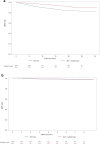Patterns of treatment and outcome of ductal carcinoma in situ in the Netherlands
- PMID: 33385265
- PMCID: PMC8062340
- DOI: 10.1007/s10549-020-06055-w
Patterns of treatment and outcome of ductal carcinoma in situ in the Netherlands
Abstract
Purpose: To spare DCIS patients from overtreatment, treatment de-escalated over the years. This study evaluates the influence of these developments on the patterns of care in the treatment of DCIS with particular interest in the use of breast conserving surgery (BCS), radiotherapy following BCS and the use and type of axillary staging.
Methods: In this large population-based cohort study all women, aged 50-74 years diagnosed with DCIS from January 1989 until January 2019, were analyzed per two-year cohort.
Results: A total of 30,417 women were diagnosed with DCIS. The proportion of patients undergoing BCS increased from 47.7% in 1995-1996 to 72.7% in 2017-2018 (p < 0.001). Adjuvant radiotherapy following BCS increased from 28.9% (1995-1996) to 89.6% (2011-2012) and subsequently decreased to 74.9% (2017-2018; p < 0.001). Since its introduction, the use of sentinel lymph node biopsy (SLNB) increased to 63.1% in 2013-2014 and subsequently decreased to 52.8% in 2017-2018 (p < 0.001). Axillary surgery is already omitted in 55.8% of the patients undergoing BCS nowadays. The five-year invasive relapse-free survival (iRFS) for BCS with adjuvant radiotherapy in the period 1989-2010, was 98.7% [CI 98.4% - 99.0%], compared to 95.0% [CI 94.1% -95.8%] for BCS only (p < 0.001). In 2011-2018, this was 99.3% [CI 99.1% - 99.5%] and 98.8% [CI 98.2% - 99.4%] respectively (p = 0.01).
Conclusions: This study shows a shift toward less extensive treatment. DCIS is increasingly treated with BCS and less often followed by additional radiotherapy. The absence of radiotherapy still results in excellent iRFS. Axillary surgery is increasingly omitted in DCIS patients.
Keywords: Breast cancer screening; Diagnostics; Ductal carcinoma in situ; Treatment.
Conflict of interest statement
The authors declare that they have no conflict of interest.
Figures






Similar articles
-
The Influence of Hospital and Surgeon Factors on the Prevalence of Axillary Lymph Node Evaluation in Ductal Carcinoma In Situ.JAMA Oncol. 2015 Jun;1(3):323-32. doi: 10.1001/jamaoncol.2015.0389. JAMA Oncol. 2015. PMID: 26181180
-
Can we select individuals with low risk ductal carcinoma in situ (DCIS)? A population-based outcomes analysis.Breast Cancer Res Treat. 2013 Apr;138(2):581-90. doi: 10.1007/s10549-013-2455-8. Epub 2013 Mar 3. Breast Cancer Res Treat. 2013. PMID: 23456231
-
Multiple foci of microinvasion is associated with an increased risk of invasive local recurrence in women with ductal carcinoma in situ treated with breast-conserving surgery.Breast Cancer Res Treat. 2019 Nov;178(1):169-176. doi: 10.1007/s10549-019-05364-z. Epub 2019 Jul 19. Breast Cancer Res Treat. 2019. PMID: 31325071
-
Patterns of invasive recurrence among patients originally treated for ductal carcinoma in situ by breast-conserving surgery versus mastectomy.Breast Cancer Res Treat. 2021 Apr;186(3):617-624. doi: 10.1007/s10549-021-06129-3. Epub 2021 Mar 6. Breast Cancer Res Treat. 2021. PMID: 33675490 Free PMC article. Review.
-
The management of ductal carcinoma in situ (DCIS). The Steering Committee on Clinical Practice Guidelines for the Care and Treatment of Breast Cancer. Canadian Association of Radiation Oncologists.CMAJ. 1998 Feb 10;158 Suppl 3:S27-34. CMAJ. 1998. PMID: 9484276 Review.
Cited by
-
An early economic evaluation of active surveillance for low-risk ductal carcinoma in situ.Future Oncol. 2024 Dec;20(40):3451-3462. doi: 10.1080/14796694.2024.2421152. Epub 2024 Dec 16. Future Oncol. 2024. PMID: 39676693 Free PMC article.
-
Contemporary Analysis of Reexcision and Conversion to Mastectomy Rates and Associated Healthcare Costs for Women Undergoing Breast-Conserving Surgery.Ann Surg Oncol. 2024 Jun;31(6):3649-3660. doi: 10.1245/s10434-024-14902-z. Epub 2024 Feb 6. Ann Surg Oncol. 2024. PMID: 38319511 Free PMC article.
-
The effects of contemporary treatment of DCIS on the risk of developing an ipsilateral invasive Breast cancer (iIBC) in the Dutch population.Breast Cancer Res Treat. 2024 Feb;204(1):61-68. doi: 10.1007/s10549-023-07168-8. Epub 2023 Nov 14. Breast Cancer Res Treat. 2024. PMID: 37964135 Free PMC article.
-
Incidence trends of ductal carcinoma in situ in New Zealand women between 1999 and 2022.Breast Cancer Res Treat. 2025 Apr;210(2):439-449. doi: 10.1007/s10549-024-07582-6. Epub 2025 Jan 25. Breast Cancer Res Treat. 2025. PMID: 39856462 Free PMC article.
-
Adherence to guideline recommendations for follow-up in patients with DCIS at a large teaching hospital in the Netherlands.Breast Cancer Res Treat. 2024 Oct;207(3):633-640. doi: 10.1007/s10549-024-07391-x. Epub 2024 Jun 14. Breast Cancer Res Treat. 2024. PMID: 38874687
References
-
- van Luijt PA, Heijnsdijk EA, Fracheboud J, Overbeek LI, Broeders MJ, Wesseling J, den Heeten GJ, de Koning HJ. The distribution of ductal carcinoma in situ (DCIS) grade in 4232 women and its impact on overdiagnosis in breast cancer screening. Breast Cancer Res. 2016;18(1):47. doi: 10.1186/s13058-016-0705-5. - DOI - PMC - PubMed
MeSH terms
LinkOut - more resources
Full Text Sources
Other Literature Sources
Medical

